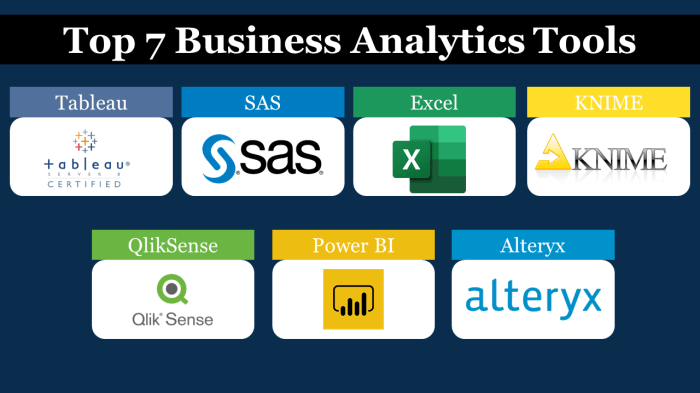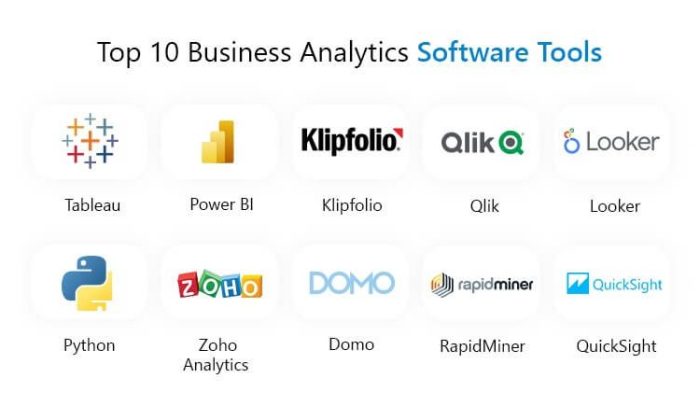Business analytics tools are essential in today’s dynamic business landscape, offering insights and strategies for decision-making and growth. From predictive analytics to data visualization platforms, these tools play a crucial role in shaping organizational success.
As we delve deeper into the world of business analytics tools, we uncover the key types, benefits, implementation strategies, and emerging trends that are revolutionizing the way businesses operate and thrive in the digital age.
Overview of Business Analytics Tools

Business analytics tools are essential software applications that help organizations analyze data to make informed decisions and improve their overall performance. These tools utilize statistical algorithms and predictive modeling to extract valuable insights from data sets, enabling businesses to identify trends, patterns, and opportunities for growth.
Popular Business Analytics Tools
- 1. Tableau: A powerful data visualization tool that allows users to create interactive dashboards and reports.
- 2. Microsoft Power BI: An intuitive business intelligence tool that enables users to analyze and visualize data from various sources.
- 3. Google Analytics: A web analytics tool that provides valuable insights into website traffic and user behavior.
- 4. IBM Cognos Analytics: A comprehensive analytics platform that helps businesses with reporting, analysis, and forecasting.
Importance of Business Analytics Tools
Business analytics tools play a crucial role in helping organizations make data-driven decisions by providing actionable insights that drive business growth. These tools enable companies to optimize processes, improve customer satisfaction, and enhance overall performance. By leveraging the power of data analytics, businesses can gain a competitive edge in today’s fast-paced market environment.
Types of Business Analytics Tools
In the world of business analytics, there are several types of tools that organizations use to gain insights from their data and make informed decisions. Let’s dive into the different categories of business analytics tools and explore their unique features and real-life applications.
Predictive Analytics
Predictive analytics tools use historical data and statistical algorithms to forecast future trends and outcomes. These tools help businesses anticipate customer behavior, identify risks, and optimize operations. For example, a retail company might use predictive analytics to forecast sales for upcoming seasons based on past trends and external factors like economic conditions.
Data Visualization Tools, Business analytics tools
Data visualization tools enable users to create visual representations of data such as charts, graphs, and dashboards. These tools make it easier for stakeholders to interpret complex data sets and identify patterns or trends. For instance, a marketing team could use data visualization tools to create interactive dashboards that track campaign performance metrics in real-time.
Business Intelligence Platforms
Business intelligence platforms combine various tools and applications to analyze and report on data from multiple sources. These platforms provide a comprehensive view of an organization’s performance and enable data-driven decision-making. An example would be a healthcare provider using a business intelligence platform to analyze patient outcomes, operational efficiency, and financial performance to improve overall care delivery.
Benefits of Using Business Analytics Tools
Using business analytics tools can revolutionize the way companies make decisions and operate. These tools offer a wide range of benefits that can significantly impact a business’s success and growth.
Improved Decision-Making
Business analytics tools provide valuable insights by analyzing data and trends, allowing companies to make informed decisions based on real-time information. These tools help businesses identify opportunities, detect potential risks, and optimize strategies for better outcomes.
Enhanced Operational Efficiency
By leveraging business analytics tools, companies can streamline their operations, automate processes, and identify areas for improvement. This leads to increased efficiency, reduced costs, and better resource utilization, ultimately driving profitability and growth.
Competitive Edge
Business analytics tools enable companies to stay ahead of the competition by leveraging data-driven insights to make strategic decisions. By understanding consumer behavior, market trends, and competitive landscapes, businesses can proactively adapt and innovate, gaining a competitive edge in the market.
Implementation of Business Analytics Tools
Implementing business analytics tools within an organization requires careful planning and execution to ensure successful integration. Let’s explore the steps involved, best practices, and challenges that may arise during the process.
Steps for Implementing Business Analytics Tools
Integrating business analytics tools into existing systems and processes can be a complex task. Here are the key steps to follow:
- Assess the organization’s needs and objectives to determine the right analytics tools to implement.
- Choose the appropriate tools that align with the organization’s goals and data requirements.
- Develop a detailed implementation plan outlining timelines, resources, and responsibilities.
- Train employees on how to use the new tools effectively to maximize their potential.
- Test the tools in a controlled environment before full deployment to identify any issues or areas for improvement.
- Monitor and evaluate the performance of the tools regularly to ensure they are meeting the organization’s objectives.
Best Practices for Integration
Integrating business analytics tools seamlessly into existing systems requires following best practices to ensure a smooth transition. Some key recommendations include:
- Collaborate with key stakeholders across departments to gather input and support for the implementation process.
- Ensure data quality and accuracy by cleaning and organizing data before integrating it into the analytics tools.
- Create a data governance framework to establish rules and policies for data management and usage within the organization.
- Regularly communicate with employees about the benefits of using analytics tools and provide ongoing training and support.
Challenges and Overcoming Them
During the implementation phase, businesses may encounter various challenges that could hinder the successful integration of analytics tools. Here are some common challenges and how to overcome them:
- Lack of data quality and consistency can impact the accuracy of insights generated. Implement data cleaning processes and quality control measures to address this issue.
- Resistance to change from employees who are accustomed to traditional methods. Offer training sessions, workshops, and incentives to encourage adoption and usage of the new tools.
- Insufficient resources and expertise for implementing and managing analytics tools. Consider outsourcing certain tasks or investing in training programs to build internal capabilities.
Trends in Business Analytics Tools

In today’s rapidly evolving business landscape, staying ahead of the curve is crucial. Business analytics tools continue to advance, with several key trends shaping the future of data analytics.
AI-driven Analytics
AI-driven analytics have revolutionized the way businesses analyze data. By leveraging artificial intelligence and machine learning algorithms, organizations can uncover valuable insights and predictions from vast amounts of data. This trend is enabling businesses to make more informed decisions, optimize processes, and drive innovation.
Self-Service Analytics
Self-service analytics empower users to analyze data and generate reports without the need for IT or data science expertise. This trend is democratizing data access within organizations, allowing employees at all levels to make data-driven decisions. With self-service analytics tools, businesses can increase agility, improve collaboration, and foster a data-driven culture.
Real-Time Data Processing
Real-time data processing is becoming increasingly important in today’s fast-paced business environment. By analyzing data as it is generated, organizations can gain real-time insights and respond quickly to changing market conditions. This trend is crucial for businesses looking to stay competitive, enhance customer experiences, and drive operational efficiency.
Overall, these trends in business analytics tools are reshaping the future of data analysis. By embracing AI-driven analytics, self-service analytics, and real-time data processing, businesses can unlock new opportunities, drive growth, and gain a competitive edge in the digital age.